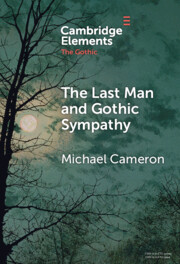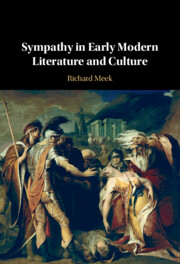80 results
5 - Romanticism, Sensibility, and Settler Women Poets
- from Part II - Networks
-
-
- Book:
- The Cambridge Companion to Australian Poetry
- Print publication:
- 13 June 2024, pp 89-100
-
- Chapter
- Export citation
Joanna Baillie on Sympathetic Curiosity and Elizabeth Hamilton's Critique
-
- Journal:
- Journal of the American Philosophical Association , First View
- Published online by Cambridge University Press:
- 18 March 2024, pp. 1-22
-
- Article
-
- You have access
- Open access
- HTML
- Export citation
6 - Loathsome Sympathy
-
-
- Book:
- Percy Shelley for Our Times
- Published online:
- 07 March 2024
- Print publication:
- 14 March 2024, pp 133-155
-
- Chapter
- Export citation
Chapter 1 - Indecision Theory
- from Part I - Provisional Judgments
-
- Book:
- The Art of Uncertainty
- Published online:
- 29 February 2024
- Print publication:
- 07 March 2024, pp 39-77
-
- Chapter
- Export citation

The Last Man and Gothic Sympathy
-
- Published online:
- 22 February 2024
- Print publication:
- 28 March 2024
-
- Element
- Export citation
Are prosocial tendencies relevant for developmental psychopathology? The relations of prosocial behavior and empathy-related responding to externalizing problems, internalizing problems, and autism spectrum disorder
-
- Journal:
- Development and Psychopathology , First View
- Published online by Cambridge University Press:
- 13 February 2024, pp. 1-11
-
- Article
-
- You have access
- Open access
- HTML
- Export citation
4 - Cultivating Humanitarianism
-
-
- Book:
- Civility, Barbarism and the Evolution of International Humanitarian Law
- Published online:
- 11 January 2024
- Print publication:
- 01 February 2024, pp 61-84
-
- Chapter
- Export citation
Chapter 4 - Theoretical Aspects of Imperial Nosology
-
- Book:
- <i>Phrenitis</i> and the Pathology of the Mind in Western Medical Thought
- Published online:
- 16 November 2023
- Print publication:
- 30 November 2023, pp 94-128
-
- Chapter
-
- You have access
- Open access
- HTML
- Export citation
Chapter 3 - Perspective Taking in Life
-
- Book:
- The Analogical Reader
- Published online:
- 09 November 2023
- Print publication:
- 23 November 2023, pp 40-79
-
- Chapter
- Export citation
3 - Changing Cultures of Execution: Religion and Feeling, 1660–1770
-
- Book:
- Execution, State and Society in England, 1660–1900
- Published online:
- 12 October 2023
- Print publication:
- 26 October 2023, pp 63-93
-
- Chapter
- Export citation
MORAL SENTIMENTS AND SELF-INTEREST IN ADAM SMITH: TWO COMMENTS
-
- Journal:
- National Institute Economic Review / Volume 265 / Autumn 2023
- Published online by Cambridge University Press:
- 03 November 2023, pp. 157-166
- Print publication:
- Autumn 2023
-
- Article
- Export citation
Chapter 6 - Xenophobia and Xenophilia
-
- Book:
- Writing, Politics and Change in South Africa after Apartheid
- Published online:
- 08 August 2023
- Print publication:
- 08 June 2023, pp 181-202
-
- Chapter
- Export citation
16 - Gender and Prosocial Development
- from Part II - Antecedents and Mechanisms of Prosociality
-
-
- Book:
- The Cambridge Handbook of Prosociality
- Published online:
- 25 May 2023
- Print publication:
- 08 June 2023, pp 320-334
-
- Chapter
- Export citation
14 - Suffering and Sympathy
- from Part II - Aspects of Ethical Agency
-
-
- Book:
- The Cambridge Handbook for the Anthropology of Ethics
- Published online:
- 11 May 2023
- Print publication:
- 25 May 2023, pp 359-388
-
- Chapter
- Export citation
Chapter 1 - ‘A sympathy of affections’
-
- Book:
- Sympathy in Early Modern Literature and Culture
- Published online:
- 27 April 2023
- Print publication:
- 13 April 2023, pp 35-71
-
- Chapter
- Export citation

Sympathy in Early Modern Literature and Culture
-
- Published online:
- 27 April 2023
- Print publication:
- 13 April 2023
Chapter 2 - ‘Compassion and mercie draw teares from the godlyfull often’
-
- Book:
- Sympathy in Early Modern Literature and Culture
- Published online:
- 27 April 2023
- Print publication:
- 13 April 2023, pp 72-102
-
- Chapter
- Export citation
Coda
-
- Book:
- Sympathy in Early Modern Literature and Culture
- Published online:
- 27 April 2023
- Print publication:
- 13 April 2023, pp 253-266
-
- Chapter
- Export citation
Chapter 4 - ‘O, what a sympathy of woe is this’
-
- Book:
- Sympathy in Early Modern Literature and Culture
- Published online:
- 27 April 2023
- Print publication:
- 13 April 2023, pp 139-175
-
- Chapter
- Export citation
Chapter 5 - ‘Soveraignes have a sympathie with subjects’
-
- Book:
- Sympathy in Early Modern Literature and Culture
- Published online:
- 27 April 2023
- Print publication:
- 13 April 2023, pp 176-214
-
- Chapter
- Export citation



